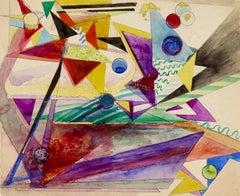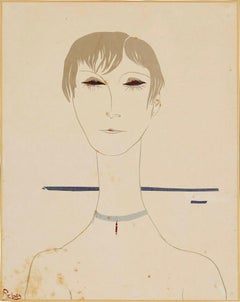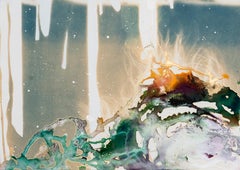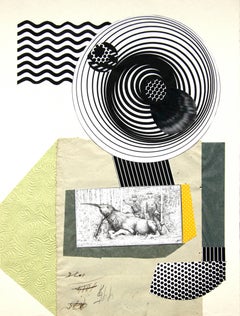Hilla Rebay von Ehrenwiesen Drawings and Watercolor Paintings
American, 1890-1967
A woman credited largely for the existence of the Solomon R. Guggenheim Museum in New York City, Hilla Rebay also was an accomplished artist in modernist styles that included collage and biogmorphic-linear oil paintings. She is remembered primarily for being the key person in first exposing the American public to avant-garde art and creating revolutionary museum environments for that art. To remind the public that Rebay was an artist in her own right, curators at the Guggenheim Museum held a retrospective of her work in the spring and summer of 2005.
Hilla Rebay was born to minor nobility in Strasbourg, Alsace. Her father, a career army officer from Bavaria, and her mother encouraged her obvious childhood art talent. She studied locally and then enrolled in 1909 at the Academie Julian in Paris.
There she was much influenced by avant-garde movements especially theosophist artists and writers led by Wassily Kandinsky. In 1910, she spent time in Munich where she was further exposed to modern art, and she returned to Paris in 1913, having exhibited work in Cologne and Munich. In Paris she studied at the Academie Julian.
By 1914, she was exhibiting with the Secession Group in Munich, the Salon des Independants in Paris, and the November Gruppe in Berlin--all rebelling against prevalent realism and traditional teaching methods. In Berlin, she associated with many modernist artists including Vasily Kandinsky, Paul Klee, and Marc Chagall. In 1917, she med Rudolph Bauer, a German painter in non-objective styles who became her long-time lover and in the future the cause of controversy because she was accused of devoting disproportionate exhibition space to him at the Guggenheim Museum.
Hilla Rebay first visited the United States in 1927 and stayed for an extended time period, which included giving painting lessons to Louise Nevelson, seeking portrait commissions, designing posters and exhibiting her own work at venues including the Worcester Art Museum and a Manhattan gallery. Among her portrait commission subjects was Solomon Guggenheim, whose wealthy family had extensive western mining interests. Rebay had met Solomon and his wife Irene when they purchased two of her paintings at the Manhattan show. To that time, the couple were collectors of conventional art, but during the sittings, Hilla talked to him of what was going on in avant-garde art circles. She brought painters of leading-edge styles to meet Guggenheim and encouraged him to collect their art, which he did--filling his Plaza Hotel apartment.
Rebay supervised the collection, and in 1937, she led the establishment of a Guggenheim foundation to build "The Museum of Non-Objective Art," in 1939. The main focus of the collection was works of the Dutch De Stijl Group that included Piet Mondrian and Theo van Doesburg, and of Bauhaus artists from Germany such as Paul Klee, Vasily Kandinsky, and Laszlo Moholy-Nagy. During this time, Rebay was reaching out to many young non-objective American artists including Jackson Pollock and Rudolf Bauer.(Biography provided by Lincoln Glenn)
to
2
3
1
2
1
2
1
Overall Height
to
Overall Width
to
2
1
3
1
2
10
807
412
288
228
3
2
2
Artist: Hilla Rebay von Ehrenwiesen
Abstract Non Objective Work on Paper Guggenheim Woman Artist Drawing 1940s w/c
By Hilla Rebay von Ehrenwiesen
Located in New York, NY
Abstract Non Objective Work on Paper Guggenheim Woman Artist 1940s Drawing w/c
HILLA REBAY (1890 - 1967, GERMAN/AMERICAN)
Abstract
watercolor and graphite on paper
14 x 16 1/2 inche...
Category
1940s Abstract Hilla Rebay von Ehrenwiesen Drawings and Watercolor Paintings
Materials
Paper, Watercolor
Abstract Non Objective Work on Paper Guggenheim Woman Artist Drawing 1940s w/c
By Hilla Rebay von Ehrenwiesen
Located in New York, NY
Abstract Non Objective Work on Paper Guggenheim Woman Artist 1940s Drawing w/c
HILLA REBAY (1890 - 1967, GERMAN/AMERICAN)
Abstract
Watercolor on paper, c. 1945. 8x9 inches.
Provenance: Estate of Hilla Rebay; Gary Snyder Fine Art, NY.
In March of 1996, Snyder Fine Art opened its exhibition, Museum of Non-Objective Painting: American Abstract Art. Gary Snyder acquired a large body of works from the Hilla Rebay Estate, many of the works on paper spent decades archivaly stored in flat files with fresh colors and immaculate paper.
BIO
A woman credited largely for the existence of the Solomon R. Guggenheim Museum in New York City, Hilla Rebay also was an accomplished artist in modernist styles that included collage and biogmorphic-linear oil paintings. She is remembered primarily for being the key person in first exposing the American public to avant-garde art and creating revolutionary museum environments for that art. To remind the public that Rebay was an artist in her own right, curators at the Guggenheim Museum held a retrospective of her work in the spring and summer of 2005.
Hilla Rebay (pronounced reh-bye) was born to minor nobility in Strasbourg, Alsace and had the full name of Baroness Hildegard Anna Augusta Elisabeth Rebay von Ehrenwiesen. Her father, a career army officer from Bavaria, and her mother encouraged her obvious childhood art talent. She studied locally and then enrolled in 1909 at the Academie Julian in Paris.
There she was much influenced by avant-garde movements especially theosophist artists and writers led by Wassily Kandinsky "who helped formulate her lifelong belief in the power of intuition in art-making and other areas of life" (Glueck). In 1910, she spent time in Munich where she was further exposed to modern art, and she returned to Paris in 1913, having exhibited work in Cologne and Munich. In Paris she studied at the Academie Julian.
By 1914, she was exhibiting with the Secession Group in Munich, the Salon des Independants in Paris, and the November Gruppe in Berlin--all rebelling against prevalent realism and traditional teaching methods. In Berlin, she associated with many modernist artists including Vasily Kandinsky, Paul Klee, and Marc Chagall. In 1917, she med Rudolph Bauer...
Category
1940s Abstract Hilla Rebay von Ehrenwiesen Drawings and Watercolor Paintings
Materials
Paper, Watercolor
Portrait of a Woman, Paper Collage
By Hilla Rebay von Ehrenwiesen
Located in Miami, FL
Hildegard Anna Augusta Elisabeth Freiin Rebay von Ehrenwiesen, known as Baroness Hilla von Rebay or simply Hilla Rebay was the co-founder of the Museum...
Category
1930s Modern Hilla Rebay von Ehrenwiesen Drawings and Watercolor Paintings
Materials
Paper
Related Items
'Corona 2' - Nature-based Abstract - Mixed Media - Cyanotype - Kapoor
By Caroline Bullock
Located in Atlanta, GA
"Corona 2," is an abstract work on paper featuring hues of gold, blue, turquoise, red, yellow, purple and white. This piece is framed in a simple white box frame behind Plexiglas mea...
Category
2010s Abstract Hilla Rebay von Ehrenwiesen Drawings and Watercolor Paintings
Materials
Acrylic, Watercolor, Archival Paper
The Antiquarian - 21st Century, Collage, Yellow, Black, Contemporary Art
By Raluca Arnăutu
Located in Berlin, DE
The Antiquarian, 2020
collage on paper
15 3/4 H x 11 13/16 W in
40 H x 30 W cm
The artist’s collages describe a series of faces composed of different materials – cardboards, textile...
Category
2010s Abstract Geometric Hilla Rebay von Ehrenwiesen Drawings and Watercolor Paintings
Materials
Paper
Free Shipping
H 19.69 in W 15.75 in D 3.94 in
Linda Turner, Art Meditation 18, Collage, Pattern and Decoration, Automatism
Located in Darien, CT
Linda Turner, raised both in NYC and Northern Virginia, resides in Brooklyn, NY. She achieved a BFA in Surface Design/Textile Design from the Fashion Inst...
Category
2010s Abstract Geometric Hilla Rebay von Ehrenwiesen Drawings and Watercolor Paintings
Materials
Archival Ink, Watercolor, Gouache, Archival Paper, Pencil, Color Pencil
Linda Turner, Meditation Is Play, Collage, Pattern and Decoration, Automatism
Located in Darien, CT
Linda Turner, raised both in NYC and Northern Virginia, resides in Brooklyn, NY. She achieved a BFA in Surface Design/Textile Design from the Fashion Inst...
Category
2010s Abstract Geometric Hilla Rebay von Ehrenwiesen Drawings and Watercolor Paintings
Materials
Watercolor, Pencil, Archival Ink, Gouache, Archival Paper, Color Pencil
Linda Turner, Art Meditation 12, Collage, Pattern and Decoration, Automatism
Located in Darien, CT
Linda Turner, raised both in NYC and Northern Virginia, resides in Brooklyn, NY. She achieved a BFA in Surface Design/Textile Design from the Fashion Inst...
Category
2010s Abstract Geometric Hilla Rebay von Ehrenwiesen Drawings and Watercolor Paintings
Materials
Archival Ink, Watercolor, Gouache, Archival Paper, Pencil, Color Pencil
Linda Turner, Art Meditation 7, Collage, Pattern and Decoration, Automatism
Located in Darien, CT
Linda Turner, raised both in NYC and Northern Virginia, resides in Brooklyn, NY. She achieved a BFA in Surface Design/Textile Design from the Fashion Inst...
Category
2010s Abstract Geometric Hilla Rebay von Ehrenwiesen Drawings and Watercolor Paintings
Materials
Archival Ink, Watercolor, Gouache, Archival Paper, Pencil, Color Pencil
Autumn Biogram of the Nelson
By Kory Twaddle
Located in Kansas City, MO
Artist : Kory Twaddle
"Autumn Biogram of the Nelson"
Newsprint, graphite, conté crayon pastel, charcoal, beeswax, cardboard, paper, gingko leaves, stickers, and Mixed Media on drawi...
Category
2010s Abstract Hilla Rebay von Ehrenwiesen Drawings and Watercolor Paintings
Materials
Paint, Paper, Conté, Charcoal, Cardboard, India Ink, Newsprint, Acrylic,...
Linda Turner, Art Meditation 5, Collage, Pattern and Decoration, Automatism
Located in Darien, CT
Linda Turner, raised both in NYC and Northern Virginia, resides in Brooklyn, NY. She achieved a BFA in Surface Design/Textile Design from the Fashion Inst...
Category
2010s Abstract Geometric Hilla Rebay von Ehrenwiesen Drawings and Watercolor Paintings
Materials
Archival Ink, Watercolor, Gouache, Archival Paper, Pencil, Color Pencil
1950s Abstract Composition in Brown, Orange and Blue with Black Parallel Lines
By Herbert Bayer
Located in Denver, CO
Watercolor and ink on paper of an abstract composition of brown, orange and blue shapes between black parallel lines throughout the the piece by Herbert Bayer (1900-1985). Presented in a custom black frame with all archival materials. Framed dimensions measure 17 ⅞ x 22 ⅝ x 1 inches. Image size is 10 ¼ x 15 ½ inches.
Painting is clean and in very good condition - please contact us for a detailed condition report.
Expedited and international shipping is available - please contact us for a quote.
About the Artist:
Herbert Bayer enjoyed a versatile sixty-year career spanning Europe and America that included abstract and surrealist painting, sculpture, environmental art, industrial design, architecture, murals, graphic design, lithography, photography and tapestry. He was one of the few “total artists” of the twentieth century, producing works that “expressed the needs of an industrial age as well as mirroring the advanced tendencies of the avant-garde.”
One of four children of a tax revenue officer growing up in a village in the Austrian Salzkammergut Lake region, Bayer developed a love of nature and a life-long attachment to the mountains. A devotee of the Vienna Secession and the Vienna Workshops (Wiener Werkstätte) whose style influenced Bauhaus craftsmen in the 1920s, his dream of studying at the Academy of Art in Vienna was dashed at age seventeen by his father’s premature death.
In 1919 Bayer began an apprenticeship with architect and designer, Georg Schmidthamer, where he produced his first typographic works. Later that same year he moved to Darmstadt, Germany, to work at the Mathildenhöhe Artists’ Colony with architect Emanuel Josef Margold of the Viennese School. As his working apprentice, Bayer first learned about the design of packages – something entirely new at the time – as well as the design of interiors and graphics of a decorative expressionist style, all of which later figured in his professional career.
While at Darmstadt, he came across Wassily Kandinsky’s book, Concerning the Spiritual in Art, and learned of the new art school, the Weimar Bauhaus, in which he enrolled in 1921. He initially attended Johannes Itten’s preliminary course, followed by Wassily Kandinsky’s workshop on mural painting. Bayer later recalled, “The early years at the Bauhaus in Weimar became the formative experience of my subsequent work.” Following graduation in 1925, he was appointed head of the newly-created workshop for print and advertising at the Dessau Bauhaus that also produced the school’s own print works. During this time he designed the “Universal” typeface emphasizing legibility by removing the ornaments from letterforms (serifs).
Three years later he left the Bauhaus to focus more on his own artwork, moving to Berlin where he worked as a graphic designer in advertising and as an artistic director of the Dorland Studio advertising agency. (Forty years later he designed a vast traveling exhibition, catalog and poster -- 50 Jahre Bauhaus -- shown in Germany, South America, Japan, Canada and the United States.) In pre-World War II Berlin he also pursued the design of exhibitions, painting, photography and photomontage, and was art director of Vogue magazine in Paris. On account of his previous association with the Bauhaus, the German Nazis removed his paintings from German museums and included him among the artists in a large exhibition entitled Degenerate Art (Entartete Kunst) that toured German and Austrian museums in 1937.
His inclusion in that exhibition and the worsening political conditions in Nazi Germany prompted him to travel to New York that year with Marcel Breuer, meeting with former Bauhaus colleagues, Walter Gropius and László Moholy-Nagy to explore the possibilities of employment after immigration to the United States. In 1938 Bayer permanently relocated to the United States, settling in New York where he had a long and distinguished career in practically every aspect of the graphic arts, working for drug companies, magazines, department stores, and industrial corporations. In 1938 he arranged the exhibition, “Bauhaus 1919-1928” at the Museum of Modern Art, followed later by “Road to Victory” (1942, directed by Edward Steichen), “Airways to Peace” (1943) and “Art in Progress” (1944).
Bayer’s designs for “Modern Art in Advertising” (1945), an exhibition of the Container Corporation of America (CAA) at the Art Institute of Chicago, earned him the support and friendship of Walter Paepcke, the corporation’s president and chairman of the board. Paepcke, whose embrace of modern currents and design changed the look of American advertising and industry, hired him to move to Aspen, Colorado, in 1946 as a design consultant transforming the moribund mountain town into a ski resort and a cultural center. Over the next twenty-eight years he became an influential catalyst in the community as a painter, graphic designer, architect and landscape designer, also serving as a design consultant for the Aspen Cultural Center.
In the summer of 1949 Bayer promoted through poster design and other design work Paepcke’s Goethe Bicentennial Convocation attended by 2,000 visitors to Aspen and highlighted by the participation of Albert Schweitzer, Arthur Rubenstein, Jose Ortega y Gasset and Thornton Wilder. The celebration, held in a tent designed by Finnish architect Eero Saarinen, led to the establishment that same year of the world-famous Aspen Music Festival and School regarded as one of the top classical music venues in the United States, and the Aspen Institute for Humanistic Studies in (now the Aspen Institute), promoting in Paepcke’s words “the cross fertilization of men’s minds.”
In 1946 Bayer completed his first architecture design project in Aspen, the Sundeck Ski Restaurant, at an elevation of 11,300 feet on Ajax Mountain. Three years later he built his first studio on Red Mountain, followed by a home which he sold in 1953 to Robert O. Anderson, founder of the Atlantic Richfield Company who became very active in the Aspen Institute. Bayer later designed Anderson’s terrace home in Aspen (1962) and a private chapel for the Anderson family in Valley Hondo, New Mexico (1963).
Transplanting German Bauhaus design to the Colorado Rockies, Bayer created along with associate architect, Fredric Benedict, a series of buildings for the modern Aspen Institute complex: Koch Seminar Building (1952), Aspen Meadows guest chalets and Center Building (both 1954), Health Center and Aspen Meadows Restaurant (Copper Kettle, both 1955). For the grounds of the Aspen Institute in 1955 Bayer executed the Marble Garden and conceived the Grass Mound, the first recorded “earthwork” environment In 1973-74 he completed Anderson Park for the Institute, a continuation of his fascination with environmental earth art.
In 1961 he designed the Walter Paepcke Auditorium and Memorial Building, completing three years later his most ambitious and original design project – the Musical Festival Tent for the Music Associates of Aspen. (In 2000 the tent was replaced with a design by Harry Teague.) One of Bayer’s ambitious plans from the 1950s, unrealized due to Paepcke’s death in 1960, was an architectural village on the outskirts of the Aspen Institute, featuring seventeen of the world’s most notable architects – Walter Gropius, Marcel Breuer, I.M. Pei, Minoru Yamasaki, Edward Durrell Stone and Phillip Johnson – who accepted his offer to design and build houses.
Concurrent with Bayer’s design and consultant work while based in Aspen for almost thirty years, he continued painting, printmaking, and mural work. Shortly after relocating to Colorado, he further developed his “Mountains and Convolutions” series begun in Vermont in 1944, exploring nature’s fury and repose. Seeing mountains as “simplified forms reduced to sculptural surface in motion,” he executed in 1948 a series of seven two-color lithographs (edition of 90) for the Colorado Springs Fine Arts Center. Colorado’s multi-planal typography similarly inspired Verdure, a large mural commissioned by Walter Gropius for the Harkness Commons Building at Harvard University (1950), and a large exterior sgraffito mural for the Koch Seminar Building at the Aspen Institute (1953).
Having exhausted by that time the subject matter of “Mountains and Convulsions,” Bayer returned to geometric abstractions which he pursued over the next three decades. In 1954 he started the “Linear Structure” series containing a richly-colored balance format with bands of sticks of continuously modulated colors. That same year he did a small group of paintings, “Forces of Time,” expressionist abstractions exploring the temporal dimension of nature’s seasonal molting. He also debuted a “Moon and Structure” series in which constructed, architectural form served as the underpinning for the elaboration of color variations and transformations.
Geometric abstraction likewise appeared his free-standing metal sculpture, Kaleidoscreen (1957), a large experimental project for ALCOA (Aluminum Corporation of America) installed as an outdoor space divider on the Aspen Meadows in the Aspen Institute complex. Composed of seven prefabricated, multi-colored and textured panels, they could be turned ninety degrees to intersect and form a continuous plane in which the panels recomposed like pieces of a jigsaw puzzle. He similarly used prefabricated elements for Articulated Wall, a very tall free-standing sculpture commissioned for the Olympic Games in Mexico...
Category
1950s Abstract Geometric Hilla Rebay von Ehrenwiesen Drawings and Watercolor Paintings
Materials
Paper, Ink, Mixed Media, Watercolor
H 17.75 in W 22.5 in D 1 in
"#56 – BOTH WOUNDED A LITTLE", ink, pencil, gouache, collage, found text, poetry
By Amy Williams
Located in Toronto, Ontario
"#56 – BOTH WOUNDED A LITTLE" is from Amy Williams' series A Farewell to Arms – wherein the artist is working directly onto page 56 of a found copy of Ernest Hemingway's WWII romance...
Category
21st Century and Contemporary Abstract Hilla Rebay von Ehrenwiesen Drawings and Watercolor Paintings
Materials
Paper, Found Objects, Ink, Gouache, Pencil
"#186 – WOUNDED WERE COMING", ink, pencil, gouache, found vintage book, poetry
By Amy Williams
Located in Toronto, Ontario
"#186 – WOUNDED WERE COMING" is from Amy Williams' series A Farewell to Arms – wherein the artist works directly onto pages of a found copy of Ernest Hemingway's WWII romance novel. The artist selects certain words and phrases from page 186 to isolate as a poem, and then draws, inks, redacts and paints the rest of the page according to the text. The resulting poem reads "The wounded were coming / men that were scared / I felt the rain in my face / It was getting dark." – Hemingway's novel is a doomed romance between a wounded American soldier and an Italian nurse – note the feminine form on the page, with a "dress" or apron that looks skeletal, bloody and rained upon, all at once.
From Amy Williams – "My recent work is focused on making treated book pages using a found vintage...
Category
21st Century and Contemporary Abstract Hilla Rebay von Ehrenwiesen Drawings and Watercolor Paintings
Materials
Paper, Found Objects, Ink, Gouache, Pencil
The Amateur - Contemporary, Collage, Figurative, Funny Character, Brown, Pink
By Raluca Arnăutu
Located in Berlin, DE
The Amateur, 2019
collage on paper
15 3/4 H x 11 13/16 W in
40 H x 30 W cm
The artist’s collages describe a series of faces composed of different materials – cardboards, textiles, f...
Category
2010s Abstract Hilla Rebay von Ehrenwiesen Drawings and Watercolor Paintings
Materials
Paper
Free Shipping
H 19.69 in W 15.75 in D 3.94 in
Hilla Rebay Von Ehrenwiesen drawings and watercolor paintings for sale on 1stDibs.
Find a wide variety of authentic Hilla Rebay von Ehrenwiesen drawings and watercolor paintings available for sale on 1stDibs. If you’re browsing the collection of drawings and watercolor paintings to introduce a pop of color in a neutral corner of your living room or bedroom, you can find work that includes elements of blue and other colors. You can also browse by medium to find art by Hilla Rebay von Ehrenwiesen in paper, paint, watercolor and more. Much of the original work by this artist or collective was created during the 20th century and is mostly associated with the abstract style. Not every interior allows for large Hilla Rebay von Ehrenwiesen drawings and watercolor paintings, so small editions measuring 14 inches across are available. Customers who are interested in this artist might also find the work of Ivan Chermayeff, Reuben Nakian, and Tim Rollins and K.O.S.. Hilla Rebay von Ehrenwiesen drawings and watercolor paintings prices can differ depending upon medium, time period and other attributes. On 1stDibs, the price for these items starts at $12,000 and tops out at $15,000, while the average work can sell for $14,000.




